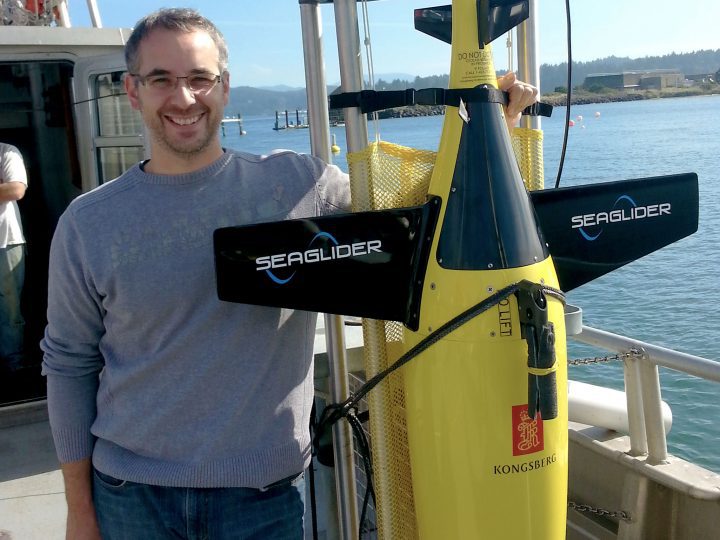Holger Klinck
John W. Fitzpatrick Director, K. Lisa Yang Center for Conservation Bioacoustics
As director of the K. Lisa Yang Center for Conservation Bioacoustics, one of my goals is to enable researchers around the globe to acoustically monitor habitats and wildlife at large spatial scales. My current research focuses on the development and application of hardware and software tools to acoustically monitor terrestrial and marine ecosystems and biodiversity. I am also studying the impacts of anthropogenic noise on the vocal and locomotive behavior of animals. I advise several undergraduate and graduate students at Cornell and Oregon State University (OSU) and I regularly teach national and international bioacoustics classes.
Before moving to the United States for a postdoctoral position at OSU, I was a Ph.D. student at the Alfred Wegener Institute for Polar and Marine Research in Germany. My graduate work focused on the development of the Perennial Acoustic Observatory in the Antarctic Ocean and the study of the vocal behavior of leopard seals (coolest animals ever!) I am a full member of the Acoustical Society of America (ASA), responsible for the ASA technical committee Animal Bioacoustics website. I joined the Cornell Lab as the director of the Bioacoustics Research Program in 2016. I am also a Faculty Fellow with the Atkinson Center for a Sustainable Future at Cornell University. In addition, I hold an Adjunct Assistant Professor position at Oregon State University (OSU), where I lead the Research Collective for Applied Acoustics.
Beyond the Lab
I am an avid college and professional sports fan. My hobbies include running, sailing, and tinkering with gadgets. My wife Karolin and I live in Ithaca and enjoy hiking with our two Australian shepherd dogs, Lilly and Sammy.
Publications
2804417
Klinck
1
the-auk
10
date
desc
title
2543
https://www.birds.cornell.edu/home/wp-content/plugins/zotpress/
%7B%22status%22%3A%22success%22%2C%22updateneeded%22%3Afalse%2C%22instance%22%3Afalse%2C%22meta%22%3A%7B%22request_last%22%3A0%2C%22request_next%22%3A0%2C%22used_cache%22%3Atrue%7D%2C%22data%22%3A%5B%7B%22key%22%3A%226VMFAAH6%22%2C%22library%22%3A%7B%22id%22%3A2804417%7D%2C%22meta%22%3A%7B%22creatorSummary%22%3A%22Clink%20et%20al.%22%2C%22parsedDate%22%3A%222025-04-19%22%2C%22numChildren%22%3A2%7D%2C%22bib%22%3A%22%26lt%3Bdiv%20class%3D%26quot%3Bcsl-bib-body%26quot%3B%20style%3D%26quot%3Bline-height%3A%201.35%3B%20padding-left%3A%201em%3B%20text-indent%3A-1em%3B%26quot%3B%26gt%3B%5Cn%20%26lt%3Bdiv%20class%3D%26quot%3Bcsl-entry%26quot%3B%26gt%3BClink%2C%20D.%20J.%2C%20J.%20Kim%2C%20H.%20Cross-Jaya%2C%20A.%20H.%20Ahmad%2C%20M.%20Hong%2C%20R.%20Sala%2C%20H.%20Birot%2C%20C.%20Agger%2C%20T.%20T.%20Vu%2C%20H.%20N.%20Thi%2C%20T.%20N.%20Chi%2C%20and%20H.%20Klinck%20%282025%29.%20%26lt%3Ba%20class%3D%26%23039%3Bzp-ItemURL%26%23039%3B%20href%3D%26%23039%3Bhttp%3A%5C%2F%5C%2Farxiv.org%5C%2Fabs%5C%2F2407.09976%26%23039%3B%26gt%3BAutomated%20detection%20of%20gibbon%20calls%20from%20passive%20acoustic%20monitoring%20data%20using%20convolutional%20neural%20networks%20in%20the%20%26quot%3Btorch%20for%20R%26quot%3B%20ecosystem%26lt%3B%5C%2Fa%26gt%3B.%20%5BOnline.%5D%20Available%20at%20%26lt%3B%5C%2Fdiv%26gt%3B%5Cn%26lt%3B%5C%2Fdiv%26gt%3B%22%2C%22data%22%3A%7B%22itemType%22%3A%22preprint%22%2C%22title%22%3A%22Automated%20detection%20of%20gibbon%20calls%20from%20passive%20acoustic%20monitoring%20data%20using%20convolutional%20neural%20networks%20in%20the%20%5C%22torch%20for%20R%5C%22%20ecosystem%22%2C%22creators%22%3A%5B%7B%22creatorType%22%3A%22author%22%2C%22firstName%22%3A%22Dena%20J.%22%2C%22lastName%22%3A%22Clink%22%7D%2C%7B%22creatorType%22%3A%22author%22%2C%22firstName%22%3A%22Jinsung%22%2C%22lastName%22%3A%22Kim%22%7D%2C%7B%22creatorType%22%3A%22author%22%2C%22firstName%22%3A%22Hope%22%2C%22lastName%22%3A%22Cross-Jaya%22%7D%2C%7B%22creatorType%22%3A%22author%22%2C%22firstName%22%3A%22Abdul%20Hamid%22%2C%22lastName%22%3A%22Ahmad%22%7D%2C%7B%22creatorType%22%3A%22author%22%2C%22firstName%22%3A%22Moeurk%22%2C%22lastName%22%3A%22Hong%22%7D%2C%7B%22creatorType%22%3A%22author%22%2C%22firstName%22%3A%22Roeun%22%2C%22lastName%22%3A%22Sala%22%7D%2C%7B%22creatorType%22%3A%22author%22%2C%22firstName%22%3A%22H%5Cu00e9l%5Cu00e8ne%22%2C%22lastName%22%3A%22Birot%22%7D%2C%7B%22creatorType%22%3A%22author%22%2C%22firstName%22%3A%22Cain%22%2C%22lastName%22%3A%22Agger%22%7D%2C%7B%22creatorType%22%3A%22author%22%2C%22firstName%22%3A%22Thinh%20Tien%22%2C%22lastName%22%3A%22Vu%22%7D%2C%7B%22creatorType%22%3A%22author%22%2C%22firstName%22%3A%22Hoa%20Nguyen%22%2C%22lastName%22%3A%22Thi%22%7D%2C%7B%22creatorType%22%3A%22author%22%2C%22firstName%22%3A%22Thanh%20Nguyen%22%2C%22lastName%22%3A%22Chi%22%7D%2C%7B%22creatorType%22%3A%22author%22%2C%22firstName%22%3A%22Holger%22%2C%22lastName%22%3A%22Klinck%22%7D%5D%2C%22abstractNote%22%3A%22Automated%20detection%20of%20acoustic%20signals%20is%20crucial%20for%20effective%20monitoring%20of%20sound-producing%20animals%20and%20their%20habitats%20across%20ecologically%20relevant%20spatial%20and%20temporal%20scales.%20Recent%20advances%20in%20deep%20learning%20have%20made%20these%20approaches%20more%20accessible.%20However%2C%20few%20deep%20learning%20approaches%20can%20be%20implemented%20natively%20in%20the%20R%20programming%20environment%3B%20approaches%20that%20run%20natively%20in%20R%20may%20be%20more%20accessible%20for%20ecologists.%20The%20%26quot%3Btorch%20for%20R%26quot%3B%20ecosystem%20has%20made%20deep%20learning%20with%20convolutional%20neural%20networks%20accessible%20for%20R%20users.%20Here%2C%20we%20evaluate%20a%20workflow%20for%20the%20automated%20detection%20and%20classification%20of%20acoustic%20signals%20from%20passive%20acoustic%20monitoring%20%28PAM%29%20data.%20Our%20specific%20goals%20include%3A%201%29%20present%20a%20method%20for%20automated%20detection%20of%20gibbon%20calls%20from%20PAM%20data%20using%20the%20%26quot%3Btorch%20for%20R%26quot%3B%20ecosystem%3B%202%29%20conduct%20a%20series%20of%20benchmarking%20experiments%20and%20compare%20the%20results%20of%20six%20CNN%20architectures%3B%20and%203%29%20investigate%20how%20well%20the%20different%20architectures%20perform%20on%20datasets%20of%20the%20female%20calls%20from%20two%20different%20gibbon%20species%3A%20the%20northern%20grey%20gibbon%20%28Hylobates%20funereus%29%20and%20the%20southern%20yellow-cheeked%20crested%20gibbon%20%28Nomascus%20gabriellae%29.%20We%20found%20that%20the%20highest-performing%20architecture%20depended%20on%20the%20species%20and%20test%20dataset.%20We%20successfully%20deployed%20the%20top-performing%20model%20for%20each%20gibbon%20species%20to%20investigate%20spatial%20variation%20in%20gibbon%20calling%20behavior%20across%20two%20grids%20of%20autonomous%20recording%20units%20in%20Danum%20Valley%20Conservation%20Area%2C%20Malaysia%20and%20Keo%20Seima%20Wildlife%20Sanctuary%2C%20Cambodia.%20The%20fields%20of%20deep%20learning%20and%20automated%20detection%20are%20rapidly%20evolving%2C%20and%20we%20provide%20the%20methods%20and%20datasets%20as%20benchmarks%20for%20future%20work.%22%2C%22genre%22%3A%22%22%2C%22repository%22%3A%22arXiv%22%2C%22archiveID%22%3A%22arXiv%3A2407.09976%22%2C%22date%22%3A%222025-04-19%22%2C%22DOI%22%3A%2210.48550%5C%2FarXiv.2407.09976%22%2C%22citationKey%22%3A%22%22%2C%22url%22%3A%22http%3A%5C%2F%5C%2Farxiv.org%5C%2Fabs%5C%2F2407.09976%22%2C%22language%22%3A%22%22%2C%22collections%22%3A%5B%222LFJB9KN%22%5D%2C%22dateModified%22%3A%222025-05-19T18%3A56%3A43Z%22%7D%7D%2C%7B%22key%22%3A%2234YZ2V27%22%2C%22library%22%3A%7B%22id%22%3A2804417%7D%2C%22meta%22%3A%7B%22creatorSummary%22%3A%22Bouffaut%20et%20al.%22%2C%22parsedDate%22%3A%222025-04-09%22%2C%22numChildren%22%3A2%7D%2C%22bib%22%3A%22%26lt%3Bdiv%20class%3D%26quot%3Bcsl-bib-body%26quot%3B%20style%3D%26quot%3Bline-height%3A%201.35%3B%20padding-left%3A%201em%3B%20text-indent%3A-1em%3B%26quot%3B%26gt%3B%5Cn%20%26lt%3Bdiv%20class%3D%26quot%3Bcsl-entry%26quot%3B%26gt%3BBouffaut%2C%20L.%2C%20Q.%20Goestchel%2C%20R.%20A.%20R%5Cu00f8rstadbotnen%2C%20A.%20Sladen%2C%20A.%20Hartog%2C%20and%20H.%20Klinck%20%282025%29.%20%26lt%3Ba%20class%3D%26%23039%3Bzp-ItemURL%26%23039%3B%20href%3D%26%23039%3Bhttps%3A%5C%2F%5C%2Fdoi.org%5C%2F10.1121%5C%2F10.0036351%26%23039%3B%26gt%3BEstimating%20sound%20pressure%20levels%20from%20distributed%20acoustic%20sensing%20data%20using%2020%5Cu2009Hz%20fin%20whale%20calls%26lt%3B%5C%2Fa%26gt%3B.%20%26lt%3Bi%26gt%3BJASA%20Express%20Letters%26lt%3B%5C%2Fi%26gt%3B%205%3A040802.%26lt%3B%5C%2Fdiv%26gt%3B%5Cn%26lt%3B%5C%2Fdiv%26gt%3B%22%2C%22data%22%3A%7B%22itemType%22%3A%22journalArticle%22%2C%22title%22%3A%22Estimating%20sound%20pressure%20levels%20from%20distributed%20acoustic%20sensing%20data%20using%2020%5Cu2009Hz%20fin%20whale%20calls%22%2C%22creators%22%3A%5B%7B%22creatorType%22%3A%22author%22%2C%22firstName%22%3A%22L%5Cu00e9a%22%2C%22lastName%22%3A%22Bouffaut%22%7D%2C%7B%22creatorType%22%3A%22author%22%2C%22firstName%22%3A%22Quentin%22%2C%22lastName%22%3A%22Goestchel%22%7D%2C%7B%22creatorType%22%3A%22author%22%2C%22firstName%22%3A%22Robin%20Andr%5Cu00e9%22%2C%22lastName%22%3A%22R%5Cu00f8rstadbotnen%22%7D%2C%7B%22creatorType%22%3A%22author%22%2C%22firstName%22%3A%22Anthony%22%2C%22lastName%22%3A%22Sladen%22%7D%2C%7B%22creatorType%22%3A%22author%22%2C%22firstName%22%3A%22Arthur%22%2C%22lastName%22%3A%22Hartog%22%7D%2C%7B%22creatorType%22%3A%22author%22%2C%22firstName%22%3A%22Holger%22%2C%22lastName%22%3A%22Klinck%22%7D%5D%2C%22abstractNote%22%3A%22Distributed%20acoustic%20sensing%20%28DAS%29%20is%20a%20promising%20technology%20for%20underwater%20acoustics%2C%20but%20its%20instrumental%20response%20is%20still%20being%20investigated%20to%20enable%20quantitative%20measurements.%20We%20use%20fin%20whale%2020%5Cu2009Hz%20calls%20to%20estimate%20the%20conversion%20between%20DAS-recorded%20strain%20and%20acoustic%20pressure.%20Our%20method%20is%20tested%20across%20three%20deployments%20on%20varied%20seafloor%20telecommunication%20cables%20and%20ocean%20basins.%20Results%20show%20that%20after%20accounting%20for%20well-established%20DAS%20response%20factors%2C%20a%20unique%20value%20for%20water%20compressibility%20provides%20a%20good%20estimate%20for%20the%20conversion.%20This%20work%20represents%20a%20significant%20step%20forward%20in%20characterizing%20DAS%20for%20marine%20monitoring%20and%20highlights%20potential%20limitations%20related%20to%20instrument%20noise%20floor.%22%2C%22date%22%3A%222025-04-09%22%2C%22language%22%3A%22%22%2C%22DOI%22%3A%2210.1121%5C%2F10.0036351%22%2C%22ISSN%22%3A%222691-1191%22%2C%22url%22%3A%22https%3A%5C%2F%5C%2Fdoi.org%5C%2F10.1121%5C%2F10.0036351%22%2C%22collections%22%3A%5B%222LFJB9KN%22%5D%2C%22dateModified%22%3A%222025-05-19T18%3A56%3A56Z%22%7D%7D%2C%7B%22key%22%3A%22IMFZNT3Z%22%2C%22library%22%3A%7B%22id%22%3A2804417%7D%2C%22meta%22%3A%7B%22creatorSummary%22%3A%22Mann%20et%20al.%22%2C%22parsedDate%22%3A%222025-04-08%22%2C%22numChildren%22%3A1%7D%2C%22bib%22%3A%22%26lt%3Bdiv%20class%3D%26quot%3Bcsl-bib-body%26quot%3B%20style%3D%26quot%3Bline-height%3A%201.35%3B%20padding-left%3A%201em%3B%20text-indent%3A-1em%3B%26quot%3B%26gt%3B%5Cn%20%26lt%3Bdiv%20class%3D%26quot%3Bcsl-entry%26quot%3B%26gt%3BMann%2C%20D.%2C%20A.%20Anderson%2C%20A.%20Donner%2C%20M.%20Hall%2C%20S.%20Kahl%2C%20and%20H.%20Klinck%20%282025%29.%20%26lt%3Ba%20class%3D%26%23039%3Bzp-ItemURL%26%23039%3B%20href%3D%26%23039%3Bhttps%3A%5C%2F%5C%2Fwww.nature.com%5C%2Farticles%5C%2Fs41598-025-94901-6%26%23039%3B%26gt%3BContinental-scale%20behavioral%20response%20of%20birds%20to%20a%20total%20solar%20eclipse%26lt%3B%5C%2Fa%26gt%3B.%20%26lt%3Bi%26gt%3BScientific%20Reports%26lt%3B%5C%2Fi%26gt%3B%2015%3A10113.%26lt%3B%5C%2Fdiv%26gt%3B%5Cn%26lt%3B%5C%2Fdiv%26gt%3B%22%2C%22data%22%3A%7B%22itemType%22%3A%22journalArticle%22%2C%22title%22%3A%22Continental-scale%20behavioral%20response%20of%20birds%20to%20a%20total%20solar%20eclipse%22%2C%22creators%22%3A%5B%7B%22creatorType%22%3A%22author%22%2C%22firstName%22%3A%22David%22%2C%22lastName%22%3A%22Mann%22%7D%2C%7B%22creatorType%22%3A%22author%22%2C%22firstName%22%3A%22Austin%22%2C%22lastName%22%3A%22Anderson%22%7D%2C%7B%22creatorType%22%3A%22author%22%2C%22firstName%22%3A%22Amy%22%2C%22lastName%22%3A%22Donner%22%7D%2C%7B%22creatorType%22%3A%22author%22%2C%22firstName%22%3A%22Michael%22%2C%22lastName%22%3A%22Hall%22%7D%2C%7B%22creatorType%22%3A%22author%22%2C%22firstName%22%3A%22Stefan%22%2C%22lastName%22%3A%22Kahl%22%7D%2C%7B%22creatorType%22%3A%22author%22%2C%22firstName%22%3A%22Holger%22%2C%22lastName%22%3A%22Klinck%22%7D%5D%2C%22abstractNote%22%3A%22Based%20on%20anecdotal%20evidence%20and%20research%20involving%20human%20observation%20and%20community%20science%2C%20radar%20analyses%2C%20and%20acoustical%20studies%2C%20birds%20are%20thought%20to%20stop%20singing%20and%20engage%20in%20nighttime%20behaviors%20such%20as%20roosting%20during%20a%20total%20solar%20eclipse.%20However%2C%20these%20research%20methodologies%20are%20limited%20by%20small%20sample%20sizes%2C%20potential%20effects%20of%20human%20observation%20altering%20birds%5Cu2019%20behaviors%2C%20and%20biases%20in%20human-recorded%20findings.%20Here%20we%20show%20how%20a%20community%20science%20network%20of%20bioacoustics%20devices%20using%20machine%20learning%20revealed%20a%20decrease%20in%20bird%20vocalization%20across%20North%20America%20at%20sites%20which%20experienced%20more%20than%2099%25%20maximum%20solar%20obscuration%20during%20the%20total%20solar%20eclipse%20on%20April%208%2C%202024.%20There%20was%20variability%20between%20sites%20in%20bird%20vocalization%20responses%20to%20a%20solar%20eclipse%20after%20controlling%20for%20human%20presence.%20A%20widely%20distributed%2C%20connected%2C%20and%20automated%20passive%20acoustics%20monitoring%20system%20will%20allow%20research%20into%20the%20impact%20on%20wildlife%20of%20wide%20spatiotemporal%2C%20continental-scale%20events%20including%20wildfires%20and%20extreme%20weather%20events.%22%2C%22date%22%3A%222025-04-08%22%2C%22language%22%3A%22en%22%2C%22DOI%22%3A%2210.1038%5C%2Fs41598-025-94901-6%22%2C%22ISSN%22%3A%222045-2322%22%2C%22url%22%3A%22https%3A%5C%2F%5C%2Fwww.nature.com%5C%2Farticles%5C%2Fs41598-025-94901-6%22%2C%22collections%22%3A%5B%222LFJB9KN%22%5D%2C%22dateModified%22%3A%222025-05-19T18%3A56%3A56Z%22%7D%7D%2C%7B%22key%22%3A%22E5XQUS5K%22%2C%22library%22%3A%7B%22id%22%3A2804417%7D%2C%22meta%22%3A%7B%22creatorSummary%22%3A%22Weidlich-Rau%20et%20al.%22%2C%22parsedDate%22%3A%222025-03-17%22%2C%22numChildren%22%3A1%7D%2C%22bib%22%3A%22%26lt%3Bdiv%20class%3D%26quot%3Bcsl-bib-body%26quot%3B%20style%3D%26quot%3Bline-height%3A%201.35%3B%20padding-left%3A%201em%3B%20text-indent%3A-1em%3B%26quot%3B%26gt%3B%5Cn%20%26lt%3Bdiv%20class%3D%26quot%3Bcsl-entry%26quot%3B%26gt%3BWeidlich-Rau%2C%20M.%2C%20A.%20K.%20Navine%2C%20P.%20T.%20Chaopricha%2C%20F.%20G%5Cu00fcnther%2C%20S.%20Kahl%2C%20T.%20Wilhelm-Stein%2C%20R.%20C.%20Mack%2C%20H.%20Reers%2C%20A.%20N.%20Rice%2C%20M.%20Eibl%2C%20P.%20J.%20Hart%2C%20et%20al.%20%282025%29.%20%26lt%3Ba%20class%3D%26%23039%3Bzp-ItemURL%26%23039%3B%20href%3D%26%23039%3Bhttps%3A%5C%2F%5C%2Fwww.sciencedirect.com%5C%2Fscience%5C%2Farticle%5C%2Fpii%5C%2FS1574954125001116%26%23039%3B%26gt%3BContinuous%20real-time%20acoustic%20monitoring%20of%20endangered%20bird%20species%20in%20Hawai%26%23039%3Bi%26lt%3B%5C%2Fa%26gt%3B.%20%26lt%3Bi%26gt%3BEcological%20Informatics%26lt%3B%5C%2Fi%26gt%3B%3A103102.%26lt%3B%5C%2Fdiv%26gt%3B%5Cn%26lt%3B%5C%2Fdiv%26gt%3B%22%2C%22data%22%3A%7B%22itemType%22%3A%22journalArticle%22%2C%22title%22%3A%22Continuous%20real-time%20acoustic%20monitoring%20of%20endangered%20bird%20species%20in%20Hawai%27i%22%2C%22creators%22%3A%5B%7B%22creatorType%22%3A%22author%22%2C%22firstName%22%3A%22Melissa%22%2C%22lastName%22%3A%22Weidlich-Rau%22%7D%2C%7B%22creatorType%22%3A%22author%22%2C%22firstName%22%3A%22Amanda%20K.%22%2C%22lastName%22%3A%22Navine%22%7D%2C%7B%22creatorType%22%3A%22author%22%2C%22firstName%22%3A%22Patrick%20T.%22%2C%22lastName%22%3A%22Chaopricha%22%7D%2C%7B%22creatorType%22%3A%22author%22%2C%22firstName%22%3A%22Felix%22%2C%22lastName%22%3A%22G%5Cu00fcnther%22%7D%2C%7B%22creatorType%22%3A%22author%22%2C%22firstName%22%3A%22Stefan%22%2C%22lastName%22%3A%22Kahl%22%7D%2C%7B%22creatorType%22%3A%22author%22%2C%22firstName%22%3A%22Thomas%22%2C%22lastName%22%3A%22Wilhelm-Stein%22%7D%2C%7B%22creatorType%22%3A%22author%22%2C%22firstName%22%3A%22Raymond%20C.%22%2C%22lastName%22%3A%22Mack%22%7D%2C%7B%22creatorType%22%3A%22author%22%2C%22firstName%22%3A%22Hendrik%22%2C%22lastName%22%3A%22Reers%22%7D%2C%7B%22creatorType%22%3A%22author%22%2C%22firstName%22%3A%22Aaron%20N.%22%2C%22lastName%22%3A%22Rice%22%7D%2C%7B%22creatorType%22%3A%22author%22%2C%22firstName%22%3A%22Maximilian%22%2C%22lastName%22%3A%22Eibl%22%7D%2C%7B%22creatorType%22%3A%22author%22%2C%22firstName%22%3A%22Patrick%20J.%22%2C%22lastName%22%3A%22Hart%22%7D%2C%7B%22creatorType%22%3A%22author%22%2C%22firstName%22%3A%22Patrick%22%2C%22lastName%22%3A%22Wolff%22%7D%2C%7B%22creatorType%22%3A%22author%22%2C%22firstName%22%3A%22Holger%22%2C%22lastName%22%3A%22Klinck%22%7D%2C%7B%22creatorType%22%3A%22author%22%2C%22firstName%22%3A%22Lena%20D.%22%2C%22lastName%22%3A%22Schnell%22%7D%2C%7B%22creatorType%22%3A%22author%22%2C%22firstName%22%3A%22Rogelio%22%2C%22lastName%22%3A%22Doratt%22%7D%2C%7B%22creatorType%22%3A%22author%22%2C%22firstName%22%3A%22Michael%22%2C%22lastName%22%3A%22Loquet%22%7D%2C%7B%22creatorType%22%3A%22author%22%2C%22firstName%22%3A%22Tiana%22%2C%22lastName%22%3A%22Lackey%22%7D%5D%2C%22abstractNote%22%3A%22The%20decline%20of%20endemic%20bird%20species%20in%20Hawai%5Cu2018i%20requires%20innovative%20conservation%20measures%20enabled%20by%20passive%20acoustic%20monitoring%20%28PAM%29.%20This%20paper%20describes%20a%20novel%20real-time%20PAM%20system%20used%20in%20the%20P%5Cu014dhakuloa%20Training%20Area%20%28PTA%29%20to%20reduce%20wildlife%20collisions%20and%20minimize%20disruptions%20to%20military%20operations%20while%20ensuring%20the%20protection%20of%20endangered%20bird%20species%20such%20as%20the%20N%5Cu0304en%5Cu0304e%20and%20%5Cu2018Ak%5Cu0304e%5Cu2019ak%5Cu0304e.%20The%20system%20is%20based%20on%20the%20BirdNET%20algorithm%20and%20was%20evaluated%20with%20over%2016%2C000%20soundscape%20recordings%20from%20Hawai%5Cu2018i.%20The%20results%20show%20that%20the%20model%20version%20HI%20V2.0%2C%20based%20on%20BirdNET%20and%20specifically%20adapted%20to%20Hawaiian%20bird%20species%2C%20showed%20the%20clearest%20separation%20between%20true%20and%20false%20positive%20detections%20%28average%20precision%2049%25%20to%2052%25%29%2C%20although%20this%20difference%20was%20not%20statistically%20significant.%20However%2C%20accuracy%20varied%20considerably%20between%20species%20and%20locations%2C%20emphasizing%20the%20need%20to%20adapt%20the%20models%20to%20the%20specific%20conditions%20of%20use.%20A%20novel%20web%20application%20allows%20immediate%20visualization%20of%20the%20predicted%20bird%20species%2C%20facilitating%20the%20implementation%20of%20conservation%20measures.%20The%20three%20acoustic%20monitoring%20units%20installed%20at%20the%20PTA%20in%20January%202023%20demonstrate%20the%20system%5Cu2019s%20potential%20for%20continuous%20monitoring%20and%20protection%20of%20Hawaiian%20endangered%20bird%20species.%22%2C%22date%22%3A%222025-03-17%22%2C%22language%22%3A%22%22%2C%22DOI%22%3A%2210.1016%5C%2Fj.ecoinf.2025.103102%22%2C%22ISSN%22%3A%221574-9541%22%2C%22url%22%3A%22https%3A%5C%2F%5C%2Fwww.sciencedirect.com%5C%2Fscience%5C%2Farticle%5C%2Fpii%5C%2FS1574954125001116%22%2C%22collections%22%3A%5B%222LFJB9KN%22%5D%2C%22dateModified%22%3A%222025-05-19T23%3A57%3A32Z%22%7D%7D%2C%7B%22key%22%3A%22IERG2LHU%22%2C%22library%22%3A%7B%22id%22%3A2804417%7D%2C%22meta%22%3A%7B%22creatorSummary%22%3A%22Garcia%20et%20al.%22%2C%22parsedDate%22%3A%222025-02-20%22%2C%22numChildren%22%3A0%7D%2C%22bib%22%3A%22%26lt%3Bdiv%20class%3D%26quot%3Bcsl-bib-body%26quot%3B%20style%3D%26quot%3Bline-height%3A%201.35%3B%20padding-left%3A%201em%3B%20text-indent%3A-1em%3B%26quot%3B%26gt%3B%5Cn%20%26lt%3Bdiv%20class%3D%26quot%3Bcsl-entry%26quot%3B%26gt%3BGarcia%2C%20M.%20L.%2C%20I.%20Tolkova%2C%20S.%20Madhusudhana%2C%20A.%20Rahaman%2C%20C.%20S.%20Baker%2C%20C.%20A.%20Mayo%2C%20C.%20A.%20Hudak%2C%20and%20H.%20Klinck%20%282025%29.%20%26lt%3Ba%20class%3D%26%23039%3Bzp-ItemURL%26%23039%3B%20href%3D%26%23039%3Bhttps%3A%5C%2F%5C%2Fwww.int-res.com%5C%2Fabstracts%5C%2Fesr%5C%2Fv56%5C%2Fp101-115%5C%2F%26%23039%3B%26gt%3BAcoustic%20abundance%20estimation%20for%20Critically%20Endangered%20North%20Atlantic%20right%20whales%20in%20Cape%20Cod%20Bay%2C%20Massachusetts%2C%20USA%26lt%3B%5C%2Fa%26gt%3B.%20%26lt%3Bi%26gt%3BEndangered%20Species%20Research%26lt%3B%5C%2Fi%26gt%3B%2056%3A101%5Cu2013115.%26lt%3B%5C%2Fdiv%26gt%3B%5Cn%26lt%3B%5C%2Fdiv%26gt%3B%22%2C%22data%22%3A%7B%22itemType%22%3A%22journalArticle%22%2C%22title%22%3A%22Acoustic%20abundance%20estimation%20for%20Critically%20Endangered%20North%20Atlantic%20right%20whales%20in%20Cape%20Cod%20Bay%2C%20Massachusetts%2C%20USA%22%2C%22creators%22%3A%5B%7B%22creatorType%22%3A%22author%22%2C%22firstName%22%3A%22Marissa%20L.%22%2C%22lastName%22%3A%22Garcia%22%7D%2C%7B%22creatorType%22%3A%22author%22%2C%22firstName%22%3A%22Irina%22%2C%22lastName%22%3A%22Tolkova%22%7D%2C%7B%22creatorType%22%3A%22author%22%2C%22firstName%22%3A%22Shyam%22%2C%22lastName%22%3A%22Madhusudhana%22%7D%2C%7B%22creatorType%22%3A%22author%22%2C%22firstName%22%3A%22Ashakur%22%2C%22lastName%22%3A%22Rahaman%22%7D%2C%7B%22creatorType%22%3A%22author%22%2C%22firstName%22%3A%22C.%20Scott%22%2C%22lastName%22%3A%22Baker%22%7D%2C%7B%22creatorType%22%3A%22author%22%2C%22firstName%22%3A%22Charles%20A.%22%2C%22lastName%22%3A%22Mayo%22%7D%2C%7B%22creatorType%22%3A%22author%22%2C%22firstName%22%3A%22Christine%20A.%22%2C%22lastName%22%3A%22Hudak%22%7D%2C%7B%22creatorType%22%3A%22author%22%2C%22firstName%22%3A%22Holger%22%2C%22lastName%22%3A%22Klinck%22%7D%5D%2C%22abstractNote%22%3A%22With%20an%20estimated%20372%20individuals%20remaining%2C%20Critically%20Endangered%20North%20Atlantic%20right%20whales%20Eubalaena%20glacialis%20%28henceforth%2C%20NARWs%29%20embody%20New%20England%5Cu2019s%20foremost%20marine%20conservation%20challenge.%20Every%20year%2C%20a%20large%20portion%20of%20the%20NARW%20population%20visits%20Cape%20Cod%20Bay%20%28CCB%29%2C%20Massachusetts%2C%20USA%2C%20a%20critical%20foraging%20area.%20Traditionally%2C%20aerial%20surveys%20have%20documented%20the%20abundance%20and%20distribution%20of%20NARWs%20in%20CCB.%20In%20this%20work%2C%20we%20demonstrate%20abundance%20estimation%20through%20passive%20acoustic%20monitoring%2C%20utilizing%20recordings%20from%20an%20array%20of%205%20marine%20autonomous%20recording%20units%20%28MARUs%29%20deployed%20from%20February%20to%20June%202019.%20We%20first%20trained%2C%20validated%2C%20and%20applied%20a%20deep-learning-based%20detector%20for%20NARW%20upcall%20vocalizations%2C%20achieving%20a%20precision%20of%200.857%20and%20recall%20of%200.896.%20Next%2C%20we%20matched%20duplicate%20detections%20across%20the%20MARU%20array%20through%20time-difference-of-arrival%20association.%20Lastly%2C%20after%20calibrating%20acoustic%20cue%20counts%20to%20concurrent%20aerial%20surveys%20conducted%20by%20the%20Center%20for%20Coastal%20Studies%2C%20we%20estimated%20daily%20NARW%20abundance%20in%20CCB%20across%20the%20foraging%20season.%20We%20demonstrated%20diel%20and%20seasonal%20patterns%20in%20acoustic%20phenology%20consistent%20with%20prior%20studies.%20Upcall%20rates%20were%20higher%20at%20night%2C%20particularly%20just%20after%20sunset%2C%20than%20during%20daylight%20hours.%20We%20observed%20low%20presence%20of%20NARWs%20in%20late%20February%2C%20with%20presence%20rising%20in%20early%20March%2C%20peaking%20in%20late%20March%20and%20early%20April%2C%20and%20ultimately%20decreasing%20through%20mid-May.%20While%20many%20sources%20of%20uncertainty%20limit%20the%20precision%20of%20abundance%20estimates%2C%20PAM%20offers%20a%20cost-effective%2C%20generalizable%2C%20and%20largely%20automated%20approach%20for%20detecting%20NARW%20abundance%20trends%20applicable%20to%20both%20conservation%20management%20and%20ecological%20studies.%22%2C%22date%22%3A%222025-02-20%22%2C%22language%22%3A%22en%22%2C%22DOI%22%3A%2210.3354%5C%2Fesr01384%22%2C%22ISSN%22%3A%221863-5407%2C%201613-4796%22%2C%22url%22%3A%22https%3A%5C%2F%5C%2Fwww.int-res.com%5C%2Fabstracts%5C%2Fesr%5C%2Fv56%5C%2Fp101-115%5C%2F%22%2C%22collections%22%3A%5B%222LFJB9KN%22%5D%2C%22dateModified%22%3A%222025-05-19T18%3A56%3A56Z%22%7D%7D%2C%7B%22key%22%3A%22CRU34U77%22%2C%22library%22%3A%7B%22id%22%3A2804417%7D%2C%22meta%22%3A%7B%22creatorSummary%22%3A%22Joly%20et%20al.%22%2C%22parsedDate%22%3A%222025%22%2C%22numChildren%22%3A1%7D%2C%22bib%22%3A%22%26lt%3Bdiv%20class%3D%26quot%3Bcsl-bib-body%26quot%3B%20style%3D%26quot%3Bline-height%3A%201.35%3B%20padding-left%3A%201em%3B%20text-indent%3A-1em%3B%26quot%3B%26gt%3B%5Cn%20%20%26lt%3Bdiv%20class%3D%26quot%3Bcsl-entry%26quot%3B%26gt%3BJoly%2C%20A.%2C%20L.%20Picek%2C%20S.%20Kahl%2C%20H.%20Go%26%23xEB%3Bau%2C%20L.%20Adam%2C%20C.%20Botella%2C%20M.%20Servajean%2C%20D.%20Marcos%2C%20C.%20Leblanc%2C%20T.%20Larcher%2C%20J.%20Matas%2C%20et%20al.%20%282025%29.%20LifeCLEF%202025%20teaser%3A%20challenges%20on%26%23xA0%3Bspecies%20presence%20prediction%20and%26%23xA0%3Bidentification%2C%20and%26%23xA0%3Bindividual%20animal%20identification.%20%26lt%3Bi%26gt%3BAdvances%20in%20Information%20Retrieval%26lt%3B%5C%2Fi%26gt%3B%20%28C.%20Hauff%2C%20C.%20Macdonald%2C%20D.%20Jannach%2C%20G.%20Kazai%2C%20F.%20M.%20Nardini%2C%20F.%20Pinelli%2C%20F.%20Silvestri%20and%20N.%20Tonellotto%2C%20Editors%29.%20Springer%20Nature%20Switzerland%2C%20Cham%2C%20pp.%20373%26%23x2013%3B381.%26lt%3B%5C%2Fdiv%26gt%3B%5Cn%26lt%3B%5C%2Fdiv%26gt%3B%22%2C%22data%22%3A%7B%22itemType%22%3A%22conferencePaper%22%2C%22title%22%3A%22LifeCLEF%202025%20teaser%3A%20challenges%20on%5Cu00a0species%20presence%20prediction%20and%5Cu00a0identification%2C%20and%5Cu00a0individual%20animal%20identification%22%2C%22creators%22%3A%5B%7B%22creatorType%22%3A%22author%22%2C%22firstName%22%3A%22Alexis%22%2C%22lastName%22%3A%22Joly%22%7D%2C%7B%22creatorType%22%3A%22author%22%2C%22firstName%22%3A%22Luk%5Cu00e1%5Cu0161%22%2C%22lastName%22%3A%22Picek%22%7D%2C%7B%22creatorType%22%3A%22author%22%2C%22firstName%22%3A%22Stefan%22%2C%22lastName%22%3A%22Kahl%22%7D%2C%7B%22creatorType%22%3A%22author%22%2C%22firstName%22%3A%22Herv%5Cu00e9%22%2C%22lastName%22%3A%22Go%5Cu00ebau%22%7D%2C%7B%22creatorType%22%3A%22author%22%2C%22firstName%22%3A%22Luk%5Cu00e1%5Cu0161%22%2C%22lastName%22%3A%22Adam%22%7D%2C%7B%22creatorType%22%3A%22author%22%2C%22firstName%22%3A%22Christophe%22%2C%22lastName%22%3A%22Botella%22%7D%2C%7B%22creatorType%22%3A%22author%22%2C%22firstName%22%3A%22Maximilien%22%2C%22lastName%22%3A%22Servajean%22%7D%2C%7B%22creatorType%22%3A%22author%22%2C%22firstName%22%3A%22Diego%22%2C%22lastName%22%3A%22Marcos%22%7D%2C%7B%22creatorType%22%3A%22author%22%2C%22firstName%22%3A%22Cesar%22%2C%22lastName%22%3A%22Leblanc%22%7D%2C%7B%22creatorType%22%3A%22author%22%2C%22firstName%22%3A%22Th%5Cu00e9o%22%2C%22lastName%22%3A%22Larcher%22%7D%2C%7B%22creatorType%22%3A%22author%22%2C%22firstName%22%3A%22Ji%5Cu0159%5Cu00ed%22%2C%22lastName%22%3A%22Matas%22%7D%2C%7B%22creatorType%22%3A%22author%22%2C%22firstName%22%3A%22Kl%5Cu00e1ra%22%2C%22lastName%22%3A%22Janou%5Cu0161kov%5Cu00e1%22%7D%2C%7B%22creatorType%22%3A%22author%22%2C%22firstName%22%3A%22Vojt%5Cu011bch%22%2C%22lastName%22%3A%22%5Cu010cerm%5Cu00e1k%22%7D%2C%7B%22creatorType%22%3A%22author%22%2C%22firstName%22%3A%22Kostas%22%2C%22lastName%22%3A%22Papafitsoros%22%7D%2C%7B%22creatorType%22%3A%22author%22%2C%22firstName%22%3A%22Robert%22%2C%22lastName%22%3A%22Planqu%5Cu00e9%22%7D%2C%7B%22creatorType%22%3A%22author%22%2C%22firstName%22%3A%22Willem-Pier%22%2C%22lastName%22%3A%22Vellinga%22%7D%2C%7B%22creatorType%22%3A%22author%22%2C%22firstName%22%3A%22Holger%22%2C%22lastName%22%3A%22Klinck%22%7D%2C%7B%22creatorType%22%3A%22author%22%2C%22firstName%22%3A%22Tom%22%2C%22lastName%22%3A%22Denton%22%7D%2C%7B%22creatorType%22%3A%22author%22%2C%22firstName%22%3A%22Pierre%22%2C%22lastName%22%3A%22Bonnet%22%7D%2C%7B%22creatorType%22%3A%22author%22%2C%22firstName%22%3A%22Henning%22%2C%22lastName%22%3A%22M%5Cu00fcller%22%7D%2C%7B%22creatorType%22%3A%22editor%22%2C%22firstName%22%3A%22Claudia%22%2C%22lastName%22%3A%22Hauff%22%7D%2C%7B%22creatorType%22%3A%22editor%22%2C%22firstName%22%3A%22Craig%22%2C%22lastName%22%3A%22Macdonald%22%7D%2C%7B%22creatorType%22%3A%22editor%22%2C%22firstName%22%3A%22Dietmar%22%2C%22lastName%22%3A%22Jannach%22%7D%2C%7B%22creatorType%22%3A%22editor%22%2C%22firstName%22%3A%22Gabriella%22%2C%22lastName%22%3A%22Kazai%22%7D%2C%7B%22creatorType%22%3A%22editor%22%2C%22firstName%22%3A%22Franco%20Maria%22%2C%22lastName%22%3A%22Nardini%22%7D%2C%7B%22creatorType%22%3A%22editor%22%2C%22firstName%22%3A%22Fabio%22%2C%22lastName%22%3A%22Pinelli%22%7D%2C%7B%22creatorType%22%3A%22editor%22%2C%22firstName%22%3A%22Fabrizio%22%2C%22lastName%22%3A%22Silvestri%22%7D%2C%7B%22creatorType%22%3A%22editor%22%2C%22firstName%22%3A%22Nicola%22%2C%22lastName%22%3A%22Tonellotto%22%7D%5D%2C%22abstractNote%22%3A%22Accurate%20identification%2C%20monitoring%2C%20and%20understanding%20of%20species%20distribution%20is%20important%20for%20biodiversity%20conservation%2C%20invasive%20species%20control%2C%20understanding%20climate%20change%2C%20and%20ecosystem%20management.%20Current%20methodologies%20for%20species%20identification%2C%20animal%20re-identification%2C%20and%20large-scale%20population%20monitoring%20are%20both%20resource-intensive%20and%20technically%20complex%2C%20posing%20significant%20challenges%20for%20widespread%20implementation.%20This%20highlights%20a%20need%20for%20automated%2C%20scalable%20solutions%20to%20enhance%20efficiency%20and%20accuracy.%20Since%202011%2C%20the%20LifeCLEF%20lab%20has%20driven%20progress%20in%20this%20field%20by%20organizing%20annual%20challenges%20to%20promote%20innovation%20in%20biodiversity%20informatics.%20The%5Cu00a02025%20edition%20introduces%20five%5Cu00a0%5Cu00a0%5Cu2013%5Cu00a0%5Cu00a0one%20new%2C%20and%20four%20continued%20%5Cu2013%20data-driven%20tasks%20aimed%20at%20addressing%20current%20challenges%20in%20species%20recognition%3A%20%28i%29%5Cu00a0AnimalCLEF%3A%20multi-species%20individual%20animal%20identification%2C%20%28ii%29%5Cu00a0BirdCLEF%3A%20bird%20species%20identification%20in%20soundscape%20recordings%2C%20%28iii%29%5Cu00a0FungiCLEF%3A%20few%20shot%20classification%20with%20rare%20fungi%20species%2C%20%28iv%29%20GeoLifeCLEF%3A%20multi-modal%20species%20prediction%20using%20remote%20sensing%20and%20large-scale%20biodiversity%20data%2C%5Cu00a0and%20%28v%29%5Cu00a0PlantCLEF%3A%20multi-species%20plant%20identification%20in%20vegetation%20plot%20images.%22%2C%22date%22%3A%222025%22%2C%22proceedingsTitle%22%3A%22Advances%20in%20Information%20Retrieval%22%2C%22conferenceName%22%3A%22%22%2C%22language%22%3A%22en%22%2C%22DOI%22%3A%2210.1007%5C%2F978-3-031-88720-8_57%22%2C%22ISBN%22%3A%22978-3-031-88720-8%22%2C%22url%22%3A%22%22%2C%22collections%22%3A%5B%222LFJB9KN%22%5D%2C%22dateModified%22%3A%222025-05-19T18%3A56%3A56Z%22%7D%7D%2C%7B%22key%22%3A%22Z734X5KJ%22%2C%22library%22%3A%7B%22id%22%3A2804417%7D%2C%22meta%22%3A%7B%22creatorSummary%22%3A%22Cooley%20et%20al.%22%2C%22parsedDate%22%3A%222024-11-02%22%2C%22numChildren%22%3A1%7D%2C%22bib%22%3A%22%26lt%3Bdiv%20class%3D%26quot%3Bcsl-bib-body%26quot%3B%20style%3D%26quot%3Bline-height%3A%201.35%3B%20padding-left%3A%201em%3B%20text-indent%3A-1em%3B%26quot%3B%26gt%3B%5Cn%20%26lt%3Bdiv%20class%3D%26quot%3Bcsl-entry%26quot%3B%26gt%3BCooley%2C%20L.%20A.%2C%20A.%20G.%20Hindle%2C%20C.%20L.%20Williams%2C%20P.%20J.%20Ponganis%2C%20S.%20M.%20Hannah%2C%20H.%20Klinck%2C%20M.%20Horning%2C%20D.%20P.%20Costa%2C%20R.%20R.%20Holser%2C%20D.%20E.%20Crocker%2C%20and%20B.%20I.%20McDonald%20%282024%29.%20%26lt%3Ba%20class%3D%26%23039%3Bzp-ItemURL%26%23039%3B%20href%3D%26%23039%3Bhttps%3A%5C%2F%5C%2Fwww.sciencedirect.com%5C%2Fscience%5C%2Farticle%5C%2Fpii%5C%2FS1095643324001983%26%23039%3B%26gt%3BPhysiological%20effects%20of%20research%20handling%20on%20the%20northern%20elephant%20seal%20%28%26lt%3Bi%26gt%3BMirounga%20angustirostris%26lt%3B%5C%2Fi%26gt%3B%29%26lt%3B%5C%2Fa%26gt%3B.%20%26lt%3Bi%26gt%3BComparative%20Biochemistry%20and%20Physiology%20Part%20A%3A%20Molecular%20%26amp%3B%20Integrative%20Physiology%26lt%3B%5C%2Fi%26gt%3B%3A111771.%26lt%3B%5C%2Fdiv%26gt%3B%5Cn%26lt%3B%5C%2Fdiv%26gt%3B%22%2C%22data%22%3A%7B%22itemType%22%3A%22journalArticle%22%2C%22title%22%3A%22Physiological%20effects%20of%20research%20handling%20on%20the%20northern%20elephant%20seal%20%28%3Ci%3EMirounga%20angustirostris%3C%5C%2Fi%3E%29%22%2C%22creators%22%3A%5B%7B%22creatorType%22%3A%22author%22%2C%22firstName%22%3A%22Lauren%20A.%22%2C%22lastName%22%3A%22Cooley%22%7D%2C%7B%22creatorType%22%3A%22author%22%2C%22firstName%22%3A%22Allyson%20G.%22%2C%22lastName%22%3A%22Hindle%22%7D%2C%7B%22creatorType%22%3A%22author%22%2C%22firstName%22%3A%22Cassondra%20L.%22%2C%22lastName%22%3A%22Williams%22%7D%2C%7B%22creatorType%22%3A%22author%22%2C%22firstName%22%3A%22Paul%20J.%22%2C%22lastName%22%3A%22Ponganis%22%7D%2C%7B%22creatorType%22%3A%22author%22%2C%22firstName%22%3A%22Shawn%20M.%22%2C%22lastName%22%3A%22Hannah%22%7D%2C%7B%22creatorType%22%3A%22author%22%2C%22firstName%22%3A%22Holger%22%2C%22lastName%22%3A%22Klinck%22%7D%2C%7B%22creatorType%22%3A%22author%22%2C%22firstName%22%3A%22Markus%22%2C%22lastName%22%3A%22Horning%22%7D%2C%7B%22creatorType%22%3A%22author%22%2C%22firstName%22%3A%22Daniel%20P.%22%2C%22lastName%22%3A%22Costa%22%7D%2C%7B%22creatorType%22%3A%22author%22%2C%22firstName%22%3A%22Rachel%20R.%22%2C%22lastName%22%3A%22Holser%22%7D%2C%7B%22creatorType%22%3A%22author%22%2C%22firstName%22%3A%22Daniel%20E.%22%2C%22lastName%22%3A%22Crocker%22%7D%2C%7B%22creatorType%22%3A%22author%22%2C%22firstName%22%3A%22Birgitte%20I.%22%2C%22lastName%22%3A%22McDonald%22%7D%5D%2C%22abstractNote%22%3A%22Wildlife%20researchers%20must%20balance%20the%20need%20to%20safely%20capture%20and%20handle%20their%20study%20animals%20to%20sample%20tissues%2C%20collect%20morphological%20measurements%2C%20and%20attach%20dataloggers%20while%20ensuring%20their%20results%20are%20not%20confounded%20by%20stress%20artifacts%20caused%20by%20handling.%20To%20determine%20the%20physiological%20effects%20of%20research%20activities%20including%20chemical%20immobilization%2C%20transport%2C%20instrumentation%20with%20biologgers%2C%20and%20overnight%20holding%20on%20a%20model%20marine%20mammal%20species%2C%20we%20collected%20hormone%2C%20blood%20chemistry%2C%20hematology%2C%20and%20heart%20rate%20data%20from%2019%20juvenile%20northern%20elephant%20seals%20%28Mirounga%20angustirostris%29%20throughout%20a%20translocation%20experiment.%20Across%20our%20six%20sampling%20timepoints%2C%20cortisol%20and%20aldosterone%20data%20revealed%20a%20moderate%20hormonal%20stress%20response%20to%20handling%20accompanied%20by%20minor%20changes%20in%20hematocrit%20and%20blood%20glucose%2C%20but%20not%20ketone%20bodies%20or%20erythrocyte%20sedimentation%20rate.%20We%20also%20examined%20heart%20rate%20as%20a%20stress%20indicator%20and%20found%20that%20interval%20heart%20rate%2C%20standard%20deviation%20of%20heart%20rate%2C%20and%20apnea-eupnea%20cycles%20were%20influenced%20by%20handling.%20However%2C%20when%20seals%20were%20recaptured%20after%20several%20days%20at%20sea%2C%20all%20hormonal%20and%20hematological%20parameters%20had%20returned%20to%20baseline%20levels.%20Furthermore%2C%20100%5Cu202f%25%20of%20study%20animals%20were%20resighted%20in%20the%20wild%20post-translocation%2C%20with%20some%20individuals%20observed%20over%20four%20years%20later.%20Together%2C%20these%20findings%20suggest%20that%20while%20northern%20elephant%20seals%20exhibit%20measurable%20physiological%20stress%20in%20response%20to%20handling%2C%20they%20recover%20rapidly%20and%20show%20no%20observable%20long-term%20deleterious%20effects%2C%20making%20them%20a%20robust%20species%20for%20ecological%20and%20physiological%20research.%22%2C%22date%22%3A%222024-11-02%22%2C%22language%22%3A%22%22%2C%22DOI%22%3A%2210.1016%5C%2Fj.cbpa.2024.111771%22%2C%22ISSN%22%3A%221095-6433%22%2C%22url%22%3A%22https%3A%5C%2F%5C%2Fwww.sciencedirect.com%5C%2Fscience%5C%2Farticle%5C%2Fpii%5C%2FS1095643324001983%22%2C%22collections%22%3A%5B%222LFJB9KN%22%5D%2C%22dateModified%22%3A%222025-05-19T18%3A56%3A56Z%22%7D%7D%2C%7B%22key%22%3A%22AX3M5J2R%22%2C%22library%22%3A%7B%22id%22%3A2804417%7D%2C%22meta%22%3A%7B%22creatorSummary%22%3A%22Bopardikar%20et%20al.%22%2C%22parsedDate%22%3A%222024-10-16%22%2C%22numChildren%22%3A1%7D%2C%22bib%22%3A%22%26lt%3Bdiv%20class%3D%26quot%3Bcsl-bib-body%26quot%3B%20style%3D%26quot%3Bline-height%3A%201.35%3B%20padding-left%3A%201em%3B%20text-indent%3A-1em%3B%26quot%3B%26gt%3B%5Cn%20%26lt%3Bdiv%20class%3D%26quot%3Bcsl-entry%26quot%3B%26gt%3BBopardikar%2C%20I.%2C%20D.%20Harris%2C%20V.%20V.%20Robin%2C%20and%20H.%20Klinck%20%282024%29.%20%26lt%3Ba%20class%3D%26%23039%3Bzp-ItemURL%26%23039%3B%20href%3D%26%23039%3Bhttps%3A%5C%2F%5C%2Fwww.researchsquare.com%5C%2Farticle%5C%2Frs-5009591%5C%2Fv1%26%23039%3B%26gt%3BComparing%20visual%20and%20acoustic%20detectability%20of%20two%20coastal%20cetacean%20species%20off%20Sindhudurg%2C%20India%2C%20to%20better%20inform%20integrated%20survey%20protocol.%26lt%3B%5C%2Fa%26gt%3B%20%26lt%3Bi%26gt%3BResearch%20Square%26lt%3B%5C%2Fi%26gt%3B.%20https%3A%5C%2F%5C%2Fdoi.org%5C%2F10.21203%5C%2Frs.3.rs-5009591%5C%2Fv1%26lt%3B%5C%2Fdiv%26gt%3B%5Cn%26lt%3B%5C%2Fdiv%26gt%3B%22%2C%22data%22%3A%7B%22itemType%22%3A%22journalArticle%22%2C%22title%22%3A%22Comparing%20visual%20and%20acoustic%20detectability%20of%20two%20coastal%20cetacean%20species%20off%20Sindhudurg%2C%20India%2C%20to%20better%20inform%20integrated%20survey%20protocol.%22%2C%22creators%22%3A%5B%7B%22creatorType%22%3A%22author%22%2C%22firstName%22%3A%22Isha%22%2C%22lastName%22%3A%22Bopardikar%22%7D%2C%7B%22creatorType%22%3A%22author%22%2C%22firstName%22%3A%22Danielle%22%2C%22lastName%22%3A%22Harris%22%7D%2C%7B%22creatorType%22%3A%22author%22%2C%22firstName%22%3A%22V.%20V.%22%2C%22lastName%22%3A%22Robin%22%7D%2C%7B%22creatorType%22%3A%22author%22%2C%22firstName%22%3A%22Holger%22%2C%22lastName%22%3A%22Klinck%22%7D%5D%2C%22abstractNote%22%3A%22The%20Indian%20Ocean%20humpback%20dolphin%20%28Sousa%20plumbea%29%20and%20the%20Indo-Pacific%20finless%20porpoise%20%28Neophocaena%20phocaenoides%29%20are%20resident%20to%20the%20inshore%20waters%20of%20India.%20Despite%20urgent%20conservation%20concerns%20facing%20both%20species%2C%20population%20assessments%2C%20and%20long-term%20monitoring%20efforts%20face%20several%20challenges%2C%20particularly%20due%20to%20limitations%20in%20conducting%20conventional%20visual%20surveys.%20Our%20study%20explores%20the%20use%20of%20combined%20acoustic%20and%20visual%20surveys%20along%20a%20376%20km2%20area%20off%20the%20Sindhudurg%20coast%2C%20India%2C%20to%20address%20these%20limitations.%20We%20begin%20by%20examining%20the%20two%20platforms%20for%20efficiency%20in%20species%20detection%20by%20comparing%20encounter%20rates%20across%20acoustic%20and%20visual%20methods.%20Acoustic%20%280.04%20groups%5C%2Fkm%29%20and%20visual%20%280.03%20groups%5C%2Fkm%29%20encounter%20rates%20for%20humpback%20dolphins%20do%20not%20show%20a%20stark%20difference.%20However%2C%20acoustic%20%280.12%20groups%5C%2Fkm%29%20and%20visual%20%280.03%20groups%5C%2Fkm%29%20encounter%20rates%20for%20finless%20porpoises%20vary%20greatly.%20Visual%20and%20acoustic%20group%20size%20estimates%20also%20vary%20for%20both%20species.%20We%20then%20use%20generalized%20additive%20mixed%20models%20%28GAMM%29%20to%20determine%20factors%20responsible%20for%20variation%20in%20detectability%20between%20the%20two%20platforms.%20Distance%20from%20shore%20and%20vessel%20traffic%20are%20variables%20affecting%20mixed%20detections%20of%20humpback%20dolphins.%20Acoustic%20detections%20for%20finless%20porpoises%20are%20most%20influenced%20by%20distance%20from%20shore%20and%20depth.%20Our%20findings%20highlight%20the%20importance%20of%20considering%20species-specific%20variations%20in%20acoustic%20and%20visual%20detectability%20when%20designing%20surveys%20for%20these%20co-occurring%20species.%22%2C%22date%22%3A%222024-10-16%22%2C%22language%22%3A%22%22%2C%22DOI%22%3A%2210.21203%5C%2Frs.3.rs-5009591%5C%2Fv1%22%2C%22ISSN%22%3A%22%22%2C%22url%22%3A%22https%3A%5C%2F%5C%2Fwww.researchsquare.com%5C%2Farticle%5C%2Frs-5009591%5C%2Fv1%22%2C%22collections%22%3A%5B%222LFJB9KN%22%5D%2C%22dateModified%22%3A%222025-05-19T18%3A56%3A43Z%22%7D%7D%2C%7B%22key%22%3A%22JKKRCLNV%22%2C%22library%22%3A%7B%22id%22%3A2804417%7D%2C%22meta%22%3A%7B%22creatorSummary%22%3A%22Wood%20et%20al.%22%2C%22parsedDate%22%3A%222024-08-23%22%2C%22numChildren%22%3A1%7D%2C%22bib%22%3A%22%26lt%3Bdiv%20class%3D%26quot%3Bcsl-bib-body%26quot%3B%20style%3D%26quot%3Bline-height%3A%201.35%3B%20padding-left%3A%201em%3B%20text-indent%3A-1em%3B%26quot%3B%26gt%3B%5Cn%20%20%26lt%3Bdiv%20class%3D%26quot%3Bcsl-entry%26quot%3B%26gt%3BWood%2C%20C.%20M.%2C%20F.%20G%26%23xFC%3Bnther%2C%20A.%20Rex%2C%20D.%20F.%20Hofstadter%2C%20H.%20Reers%2C%20S.%20Kahl%2C%20M.%20Z.%20Peery%2C%20and%20H.%20Klinck%20%282024%29.%20Real-time%20acoustic%20monitoring%20facilitates%20the%20proactive%20management%20of%20biological%20invasions.%20%26lt%3Bi%26gt%3BBiological%20Invasions%26lt%3B%5C%2Fi%26gt%3B.%20%26lt%3Ba%20class%3D%26%23039%3Bzp-DOIURL%26%23039%3B%20href%3D%26%23039%3Bhttps%3A%5C%2F%5C%2Fdoi.org%5C%2Fhttps%3A%5C%2F%5C%2Fdoi.org%5C%2F10.1007%5C%2Fs10530-024-03426-y%26%23039%3B%26gt%3Bhttps%3A%5C%2F%5C%2Fdoi.org%5C%2Fhttps%3A%5C%2F%5C%2Fdoi.org%5C%2F10.1007%5C%2Fs10530-024-03426-y%26lt%3B%5C%2Fa%26gt%3B%26lt%3B%5C%2Fdiv%26gt%3B%5Cn%26lt%3B%5C%2Fdiv%26gt%3B%22%2C%22data%22%3A%7B%22itemType%22%3A%22journalArticle%22%2C%22title%22%3A%22Real-time%20acoustic%20monitoring%20facilitates%20the%20proactive%20management%20of%20biological%20invasions%22%2C%22creators%22%3A%5B%7B%22creatorType%22%3A%22author%22%2C%22firstName%22%3A%22C.%20M.%22%2C%22lastName%22%3A%22Wood%22%7D%2C%7B%22creatorType%22%3A%22author%22%2C%22firstName%22%3A%22F.%22%2C%22lastName%22%3A%22G%5Cu00fcnther%22%7D%2C%7B%22creatorType%22%3A%22author%22%2C%22firstName%22%3A%22A.%22%2C%22lastName%22%3A%22Rex%22%7D%2C%7B%22creatorType%22%3A%22author%22%2C%22firstName%22%3A%22D.%20F.%22%2C%22lastName%22%3A%22Hofstadter%22%7D%2C%7B%22creatorType%22%3A%22author%22%2C%22firstName%22%3A%22H.%22%2C%22lastName%22%3A%22Reers%22%7D%2C%7B%22creatorType%22%3A%22author%22%2C%22firstName%22%3A%22S.%22%2C%22lastName%22%3A%22Kahl%22%7D%2C%7B%22creatorType%22%3A%22author%22%2C%22firstName%22%3A%22M.%20Z.%22%2C%22lastName%22%3A%22Peery%22%7D%2C%7B%22creatorType%22%3A%22author%22%2C%22firstName%22%3A%22H.%22%2C%22lastName%22%3A%22Klinck%22%7D%5D%2C%22abstractNote%22%3A%22%22%2C%22date%22%3A%222024-08-23%22%2C%22language%22%3A%22%22%2C%22DOI%22%3A%22https%3A%5C%2F%5C%2Fdoi.org%5C%2F10.1007%5C%2Fs10530-024-03426-y%22%2C%22ISSN%22%3A%22%22%2C%22url%22%3A%22%22%2C%22collections%22%3A%5B%22SNRZ7X8F%22%2C%222LFJB9KN%22%5D%2C%22dateModified%22%3A%222025-05-19T20%3A17%3A26Z%22%7D%7D%2C%7B%22key%22%3A%22YJBZHPBF%22%2C%22library%22%3A%7B%22id%22%3A2804417%7D%2C%22meta%22%3A%7B%22creatorSummary%22%3A%22Madhusudhana%20et%20al.%22%2C%22parsedDate%22%3A%222024-05-06%22%2C%22numChildren%22%3A1%7D%2C%22bib%22%3A%22%26lt%3Bdiv%20class%3D%26quot%3Bcsl-bib-body%26quot%3B%20style%3D%26quot%3Bline-height%3A%201.35%3B%20padding-left%3A%201em%3B%20text-indent%3A-1em%3B%26quot%3B%26gt%3B%5Cn%20%26lt%3Bdiv%20class%3D%26quot%3Bcsl-entry%26quot%3B%26gt%3BMadhusudhana%2C%20S.%2C%20H.%20Klinck%2C%20and%20L.%20B.%20Symes%20%282024%29.%20%26lt%3Ba%20class%3D%26%23039%3Bzp-ItemURL%26%23039%3B%20href%3D%26%23039%3Bhttps%3A%5C%2F%5C%2Froyalsocietypublishing.org%5C%2Fdoi%5C%2Ffull%5C%2F10.1098%5C%2Frstb.2023.0444%26%23039%3B%26gt%3BExtensive%20data%20engineering%20to%20the%20rescue%3A%20building%20a%20multi-species%20katydid%20detector%20from%20unbalanced%2C%20atypical%20training%20datasets%26lt%3B%5C%2Fa%26gt%3B.%20%26lt%3Bi%26gt%3BPhilosophical%20Transactions%20of%20the%20Royal%20Society%20B%3A%20Biological%20Sciences%26lt%3B%5C%2Fi%26gt%3B%20379%3A20230444.%26lt%3B%5C%2Fdiv%26gt%3B%5Cn%26lt%3B%5C%2Fdiv%26gt%3B%22%2C%22data%22%3A%7B%22itemType%22%3A%22journalArticle%22%2C%22title%22%3A%22Extensive%20data%20engineering%20to%20the%20rescue%3A%20building%20a%20multi-species%20katydid%20detector%20from%20unbalanced%2C%20atypical%20training%20datasets%22%2C%22creators%22%3A%5B%7B%22creatorType%22%3A%22author%22%2C%22firstName%22%3A%22S.%22%2C%22lastName%22%3A%22Madhusudhana%22%7D%2C%7B%22creatorType%22%3A%22author%22%2C%22firstName%22%3A%22H.%22%2C%22lastName%22%3A%22Klinck%22%7D%2C%7B%22creatorType%22%3A%22author%22%2C%22firstName%22%3A%22L.%20B.%22%2C%22lastName%22%3A%22Symes%22%7D%5D%2C%22abstractNote%22%3A%22Passive%20acoustic%20monitoring%20%28PAM%29%20is%20a%20powerful%20tool%20for%20studying%20ecosystems.%20However%2C%20its%20effective%20application%20in%20tropical%20environments%2C%20particularly%20for%20insects%2C%20poses%20distinct%20challenges.%20Neotropical%20katydids%20produce%20complex%20species-specific%20calls%2C%20spanning%20mere%20milliseconds%20to%20seconds%20and%20spread%20across%20broad%20audible%20and%20ultrasonic%20frequencies.%20However%2C%20subtle%20differences%20in%20inter-pulse%20intervals%20or%20central%20frequencies%20are%20often%20the%20only%20discriminatory%20traits.%20These%20extremities%2C%20coupled%20with%20low%20source%20levels%20and%20susceptibility%20to%20masking%20by%20ambient%20noise%2C%20challenge%20species%20identification%20in%20PAM%20recordings.%20This%20study%20aimed%20to%20develop%20a%20deep%20learning-based%20solution%20to%20automate%20the%20recognition%20of%2031%20katydid%20species%20of%20interest%20in%20a%20biodiverse%20Panamanian%20forest%20with%20over%2080%20katydid%20species.%20Besides%20the%20innate%20challenges%2C%20our%20efforts%20were%20also%20encumbered%20by%20a%20limited%20and%20imbalanced%20initial%20training%20dataset%20comprising%20domain-mismatched%20recordings.%20To%20overcome%20these%2C%20we%20applied%20rigorous%20data%20engineering%2C%20improving%20input%20variance%20through%20controlled%20playback%20re-recordings%20and%20by%20employing%20physics-based%20data%20augmentation%20techniques%2C%20and%20tuning%20signal-processing%2C%20model%20and%20training%20parameters%20to%20produce%20a%20custom%20well-fit%20solution.%20Methods%20developed%20here%20are%20incorporated%20into%20Koogu%2C%20an%20open-source%20Python-based%20toolbox%20for%20developing%20deep%20learning-based%20bioacoustic%20analysis%20solutions.%20The%20parametric%20implementations%20offer%20a%20valuable%20resource%2C%20enhancing%20the%20capabilities%20of%20PAM%20for%20studying%20insects%20in%20tropical%20ecosystems.%5CnThis%20article%20is%20part%20of%20the%20theme%20issue%20%5Cu2018Towards%20a%20toolkit%20for%20global%20insect%20biodiversity%20monitoring%5Cu2019.%22%2C%22date%22%3A%222024-05-06%22%2C%22language%22%3A%22%22%2C%22DOI%22%3A%2210.1098%5C%2Frstb.2023.0444%22%2C%22ISSN%22%3A%22%22%2C%22url%22%3A%22https%3A%5C%2F%5C%2Froyalsocietypublishing.org%5C%2Fdoi%5C%2Ffull%5C%2F10.1098%5C%2Frstb.2023.0444%22%2C%22collections%22%3A%5B%22SNRZ7X8F%22%5D%2C%22dateModified%22%3A%222024-10-29T03%3A26%3A19Z%22%7D%7D%5D%7D
Clink, D. J., J. Kim, H. Cross-Jaya, A. H. Ahmad, M. Hong, R. Sala, H. Birot, C. Agger, T. T. Vu, H. N. Thi, T. N. Chi, and H. Klinck (2025).
Automated detection of gibbon calls from passive acoustic monitoring data using convolutional neural networks in the "torch for R" ecosystem. [Online.] Available at
Bouffaut, L., Q. Goestchel, R. A. Rørstadbotnen, A. Sladen, A. Hartog, and H. Klinck (2025).
Estimating sound pressure levels from distributed acoustic sensing data using 20 Hz fin whale calls.
JASA Express Letters 5:040802.
Mann, D., A. Anderson, A. Donner, M. Hall, S. Kahl, and H. Klinck (2025).
Continental-scale behavioral response of birds to a total solar eclipse.
Scientific Reports 15:10113.
Weidlich-Rau, M., A. K. Navine, P. T. Chaopricha, F. Günther, S. Kahl, T. Wilhelm-Stein, R. C. Mack, H. Reers, A. N. Rice, M. Eibl, P. J. Hart, et al. (2025).
Continuous real-time acoustic monitoring of endangered bird species in Hawai'i.
Ecological Informatics:103102.
Garcia, M. L., I. Tolkova, S. Madhusudhana, A. Rahaman, C. S. Baker, C. A. Mayo, C. A. Hudak, and H. Klinck (2025).
Acoustic abundance estimation for Critically Endangered North Atlantic right whales in Cape Cod Bay, Massachusetts, USA.
Endangered Species Research 56:101–115.
Joly, A., L. Picek, S. Kahl, H. Goëau, L. Adam, C. Botella, M. Servajean, D. Marcos, C. Leblanc, T. Larcher, J. Matas, et al. (2025). LifeCLEF 2025 teaser: challenges on species presence prediction and identification, and individual animal identification. Advances in Information Retrieval (C. Hauff, C. Macdonald, D. Jannach, G. Kazai, F. M. Nardini, F. Pinelli, F. Silvestri and N. Tonellotto, Editors). Springer Nature Switzerland, Cham, pp. 373–381.
Cooley, L. A., A. G. Hindle, C. L. Williams, P. J. Ponganis, S. M. Hannah, H. Klinck, M. Horning, D. P. Costa, R. R. Holser, D. E. Crocker, and B. I. McDonald (2024).
Physiological effects of research handling on the northern elephant seal (Mirounga angustirostris).
Comparative Biochemistry and Physiology Part A: Molecular & Integrative Physiology:111771.
Wood, C. M., F. Günther, A. Rex, D. F. Hofstadter, H. Reers, S. Kahl, M. Z. Peery, and H. Klinck (2024). Real-time acoustic monitoring facilitates the proactive management of biological invasions.
Biological Invasions.
https://doi.org/https://doi.org/10.1007/s10530-024-03426-y
Madhusudhana, S., H. Klinck, and L. B. Symes (2024).
Extensive data engineering to the rescue: building a multi-species katydid detector from unbalanced, atypical training datasets.
Philosophical Transactions of the Royal Society B: Biological Sciences 379:20230444.

